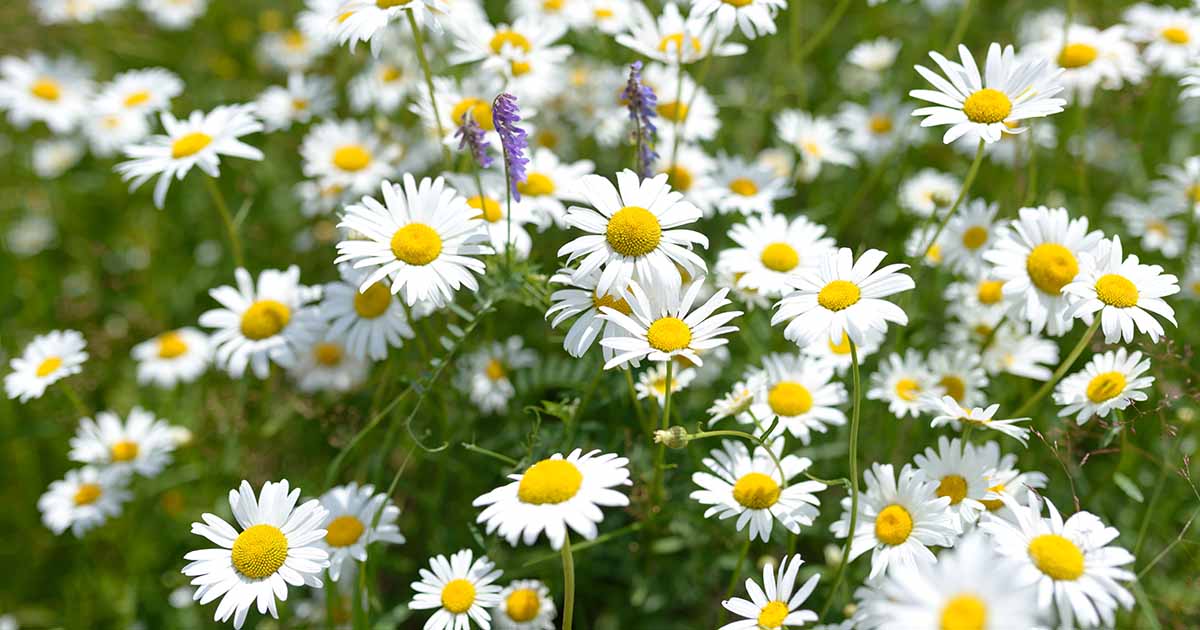How To Use Chamomile Lawn For Natural Pest Control offers a beautiful and effective way to manage pesky insects in your yard. This fragrant herb, known for its calming properties, also acts as a natural deterrent to a variety of common lawn pests.
Chamomile lawns provide a sustainable and eco-friendly alternative to chemical pesticides, promoting a healthier environment for you, your family, and your beloved pollinators.
Growing a chamomile lawn is a rewarding experience, not only for its pest-repelling abilities but also for its charming aesthetic and potential medicinal benefits. This guide will delve into the steps involved in creating and maintaining a thriving chamomile lawn, exploring the pests it effectively repels, and discussing the advantages of using chamomile as a natural pest control solution.
Pests Targeted by Chamomile

Chamomile, with its distinct aroma and natural compounds, serves as a deterrent to a variety of common lawn pests. Its ability to repel these unwanted visitors stems from its chemical makeup, which includes compounds like pyrethrin and azulene, both known for their insecticidal and anti-fungal properties.
How Chamomile Repels Pests
Chamomile’s effectiveness in pest control is attributed to its ability to disrupt the normal behavior of insects and other pests. The scent of chamomile, particularly the strong, pungent aroma of its flowers, can be overwhelming for some pests, causing them to avoid areas where the plant is present.
This is due to the presence of pyrethrin, a natural insecticide found in chamomile, which can act as a nerve toxin to insects, leading to paralysis or death. Additionally, chamomile’s bitter taste can discourage pests from feeding on it, effectively deterring them from damaging the lawn.
Examples of Pests Repelled by Chamomile
- Aphids:These tiny, sap-sucking insects can cause significant damage to plants, weakening them and making them more susceptible to disease. Chamomile’s strong scent and pyrethrin content effectively deter aphids, keeping them away from the lawn.
- Ants:Ants, known for their foraging habits, can be a nuisance in the lawn, disrupting its aesthetics and potentially damaging plants. Chamomile’s scent can disrupt their communication trails, making it difficult for them to navigate and establish colonies in the lawn.
- Slugs and Snails:These slimy creatures can leave trails of damage on lawns, feasting on tender shoots and leaves. Chamomile’s bitter taste and the presence of azulene, a compound known for its anti-fungal properties, make the lawn less appealing to slugs and snails.
Chamomile Lawn Maintenance
A healthy chamomile lawn requires consistent maintenance to thrive and effectively deter pests. Proper care ensures the lawn remains lush, attractive, and capable of producing the beneficial compounds that repel insects.
Chamomile lawns are a natural way to deter pests, offering a fragrant and chemical-free solution. These low-maintenance lawns are also a great complement to other plants, like hydrangeas, which thrive in similar conditions. If you’re interested in creating a hydrangea garden with low-maintenance companion plants, check out this article on Creating a Hydrangea Garden With Low-Maintenance Companion Plants.
By incorporating chamomile into your landscape, you can enjoy a beautiful and pest-free garden that’s easy to maintain.
Mowing and Watering, How To Use Chamomile Lawn For Natural Pest Control
Regular mowing and watering are crucial for a healthy chamomile lawn.
- Mow the lawn regularly, but not too short. Aim for a height of 2-3 inches. This encourages bushier growth and helps the lawn maintain its dense, pest-repelling qualities.
- Water deeply and infrequently. Allow the soil to dry slightly between waterings to encourage strong root development. Avoid overwatering, which can lead to fungal diseases and weaken the chamomile.
Controlling Weeds and Other Unwanted Plants
Chamomile lawns are generally resistant to weeds, but some may still appear.
Chamomile lawns are a beautiful and effective way to deter pests naturally, offering a fragrant alternative to chemical pesticides. While you may be focused on your lawn, remember that similar principles apply to other areas of your garden, such as your Bonsai collection.
Just as chamomile can repel insects in your lawn, certain plants can be strategically placed around your bonsai to deter pests and create a harmonious ecosystem. By applying these natural methods, you can enjoy a pest-free and thriving lawn and bonsai collection.
- Hand-pulling weeds is the most effective and environmentally friendly method. This prevents the introduction of herbicides that could harm beneficial insects and the chamomile itself.
- Mulching can help suppress weed growth. Apply a layer of organic mulch, such as shredded bark or compost, around the base of the chamomile plants to create a barrier against weeds.
- Use a non-selective herbicide, such as glyphosate, only as a last resort. Apply it carefully to avoid damaging the chamomile lawn.
Alternative Pest Control Methods

While chamomile is a powerful natural pest repellent, combining it with other methods can create a more comprehensive and effective approach to pest management. By employing a multi-faceted strategy, you can further enhance the protective barrier of your chamomile lawn.
Companion Planting
Companion planting involves strategically placing different plants together to benefit from their mutualistic relationships. Certain herbs and flowers possess natural pest-repelling properties that complement chamomile’s actions.
“Companion planting can be a valuable tool in organic gardening, creating a more diverse and resilient ecosystem that discourages pests and attracts beneficial insects.”
- Marigolds:Known for their pungent scent, marigolds deter nematodes, aphids, and whiteflies. Planting them around your chamomile lawn can create a protective barrier against these pests.
- Rosemary:This aromatic herb repels a wide range of insects, including moths, beetles, and flies. Its strong scent can deter pests from entering your lawn.
- Lavender:Lavender’s fragrant flowers are known to repel mosquitoes, flies, and other flying insects. Planting it near your chamomile lawn can create a more pleasant and pest-free environment.
Beneficial Insects
Introducing beneficial insects to your lawn can help control pest populations naturally. These insects act as predators or parasites of harmful pests, maintaining a balanced ecosystem.
- Ladybugs:These voracious predators feed on aphids, mealybugs, and other soft-bodied insects, effectively controlling their populations.
- Lacewings:Lacewings are highly effective predators of aphids, mealybugs, and other small insects, making them valuable allies in pest control.
- Praying Mantises:Praying mantises are voracious predators that can control a wide range of pests, including caterpillars, beetles, and grasshoppers.
Benefits Beyond Pest Control
Chamomile lawns offer advantages beyond their natural pest control capabilities. The delicate blooms and pleasant aroma enhance the aesthetic appeal of your outdoor space, while the plant’s medicinal properties provide potential health benefits. Moreover, opting for a chamomile lawn contributes to a more sustainable and environmentally friendly approach to lawn care.
Aesthetic Appeal
Chamomile lawns possess a unique charm that sets them apart from traditional grass lawns. The delicate white daisy-like flowers add a touch of elegance and whimsy to your landscape. The low-growing, feathery foliage creates a soft, inviting texture, making it ideal for barefoot walks or relaxing picnics.
The gentle fragrance of chamomile flowers, reminiscent of apples and honey, fills the air with a soothing aroma, enhancing the overall ambiance of your outdoor space.
Medicinal Properties
Chamomile has been used for centuries for its medicinal properties. The flowers contain compounds with potential therapeutic benefits, including anti-inflammatory, anti-anxiety, and sleep-promoting effects.
- Anti-inflammatory properties: Chamomile is known for its ability to reduce inflammation, making it beneficial for treating skin conditions like eczema and psoriasis.
- Anti-anxiety effects: Chamomile tea is often consumed to relieve anxiety and promote relaxation. Studies have shown that chamomile may have a calming effect on the nervous system.
- Sleep-promoting effects: Chamomile is traditionally used as a sleep aid. Its calming properties may help improve sleep quality and duration.
While more research is needed to fully understand the medicinal properties of chamomile, its long history of use suggests its potential benefits for overall well-being.
Chamomile lawns offer a natural way to deter pests, but remember that even the most resilient plants need proper care. Just like your chamomile lawn, the Money Plant thrives with consistent watering and well-draining soil. Applying these same principles to your chamomile lawn will ensure its health and pest-repelling abilities.
Environmental Benefits
Choosing a chamomile lawn over a traditional grass lawn contributes to a more sustainable and environmentally friendly approach to landscaping.
- Reduced water usage: Chamomile is a drought-tolerant plant that requires less water than traditional grass, making it a water-wise choice for landscaping.
- Reduced chemical usage: Chamomile’s natural pest-repelling properties reduce the need for chemical pesticides, promoting a healthier environment for you and your family.
- Soil health improvement: Chamomile is known to improve soil health by attracting beneficial insects and microorganisms.
By opting for a chamomile lawn, you can contribute to a greener and more sustainable future.
Ultimate Conclusion: How To Use Chamomile Lawn For Natural Pest Control

By embracing the power of chamomile, you can create a vibrant and healthy lawn that thrives naturally. With its ability to repel common lawn pests, chamomile offers a sustainable and environmentally friendly approach to pest control. From its beautiful blooms to its calming aroma, a chamomile lawn is a testament to the power of nature’s solutions.
So, consider planting a chamomile lawn today and enjoy the benefits of a beautiful, pest-free, and naturally healthy outdoor space.
FAQ Resource
Can I plant chamomile in my existing lawn?
Yes, you can! You can overseed your existing lawn with chamomile seeds. However, you might need to thin out some of your existing grass to allow the chamomile to establish itself.
How often should I mow my chamomile lawn?
Chamomile lawns should be mowed regularly, about once a week, to maintain their height and prevent them from becoming too thick. However, avoid cutting the lawn too short, as this can damage the plants.
Is chamomile toxic to pets?
Chamomile is generally considered safe for pets. However, some animals may experience mild digestive upset if they consume large quantities. If you have concerns, consult with your veterinarian.
